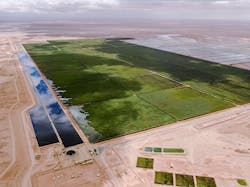MUSCAT, Oman – German engineering company Bauer Nimr will expand the world’s largest constructed wetland as part of a contract with oil and gas company Petroleum Development Oman (PDO).
Originally completed in 2011, the project was expanded in 2014 to 115,000 m3/day but this latest expansion will take the capacity to 175,000 m3/day.
Bauer Nimr will design, construct and operate the site until 2044, which includes a 25-year operational period following construction completion slated for the end of 2019.
The treatment includes gravity-flow and natural processes to reduce heavy hydrocarbon loads from the industrial wastewater down to below 0.5 parts per million.
Around 95 percent of crude oil entering the facility is estimated to be recovered by the process, without the need for additional chemicals.
Peter Hingott, chairman of the board, Bauer Nimr, reportedly said: “The Nimr water treatment plant in Oman is one of our most significant projects. The outstanding partnership with PDO will enable us to continue on this path of joint success.”
###
Read more
Constructed wetlands: Unlocking water treatment technology at Shell



